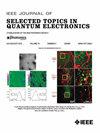Lateral Quantum-Confined Stark Effect for Integrated Quantum Dot Electroabsorption Modulators
IF 5.1
2区 工程技术
Q1 ENGINEERING, ELECTRICAL & ELECTRONIC
IEEE Journal of Selected Topics in Quantum Electronics
Pub Date : 2025-03-17
DOI:10.1109/JSTQE.2025.3552024
引用次数: 0
Abstract
Advances in III-V on Si quantum dot (QD) growth have enabled monolithic integration of high-performance electrically-pumped lasers on Si, as an enabling component for Si photonics. Another critical component is the electroabsorption modulator (EAM), which exploits the quantum-confined Stark effect (QCSE) to achieve high-speed modulation of laser signals. Conventional quantum well (QW) EAMs exploit a “vertical” QCSE via top and bottom electrical contacts. Rapid advancements in planar photonic integrated circuit technology motivate development of laterally-contacted EAMs, which offer benefits including reduced parasitic capacitance. The QCSE cannot be achieved via a lateral field in a QW, but can in a QD due to the three-dimensional carrier confinement. Here, theoretical analysis of the lateral-field QCSE in 1.3集成量子点电吸收调制器的横向量子受限Stark效应
硅量子点(QD)生长的III-V进展使高性能电泵激光器在硅上的单片集成成为可能,作为硅光子学的使能组件。另一个关键部件是电吸收调制器(EAM),它利用量子限制斯塔克效应(QCSE)实现激光信号的高速调制。传统的量子阱(QW) eam通过顶部和底部电触点利用“垂直”QCSE。平面光子集成电路技术的快速发展促进了横向接触eam的发展,其优点包括减少寄生电容。QCSE不能通过QW中的横向场实现,但由于三维载流子约束,可以在QD中实现。本文对1.3 $\mu$m in $_{x}$Ga$_{1-x}$As/GaAs量子点的横向场QCSE进行了理论分析。比较垂直电场和横向电场产生的QCSE对实际QD形态的影响,证明了一个强大的横向场QCSE,其光学吸收边缘红移比传统的QW-EAM更快。结果表明,横向场QD-EAM的性能对带边吸收的谱线宽度非常敏感,也与横向电场的面内取向有关。QD形态的影响-基本形状,纵横比和组成轮廓-也被量化。结果表明,具有高长宽比和低吸收线宽的In$_{x}$Ga$_{1-x}$As/GaAs量子点非常适合用于发展横向场qd - eam。这表明利用Si外延上的III-V将eam与激光或单光子源集成在一起,实现高速Si光子集成电路,用于数据通信和线性光学量子计算。
本文章由计算机程序翻译,如有差异,请以英文原文为准。
求助全文
约1分钟内获得全文
求助全文
来源期刊

IEEE Journal of Selected Topics in Quantum Electronics
工程技术-工程:电子与电气
CiteScore
10.60
自引率
2.00%
发文量
212
审稿时长
3 months
期刊介绍:
Papers published in the IEEE Journal of Selected Topics in Quantum Electronics fall within the broad field of science and technology of quantum electronics of a device, subsystem, or system-oriented nature. Each issue is devoted to a specific topic within this broad spectrum. Announcements of the topical areas planned for future issues, along with deadlines for receipt of manuscripts, are published in this Journal and in the IEEE Journal of Quantum Electronics. Generally, the scope of manuscripts appropriate to this Journal is the same as that for the IEEE Journal of Quantum Electronics. Manuscripts are published that report original theoretical and/or experimental research results that advance the scientific and technological base of quantum electronics devices, systems, or applications. The Journal is dedicated toward publishing research results that advance the state of the art or add to the understanding of the generation, amplification, modulation, detection, waveguiding, or propagation characteristics of coherent electromagnetic radiation having sub-millimeter and shorter wavelengths. In order to be suitable for publication in this Journal, the content of manuscripts concerned with subject-related research must have a potential impact on advancing the technological base of quantum electronic devices, systems, and/or applications. Potential authors of subject-related research have the responsibility of pointing out this potential impact. System-oriented manuscripts must be concerned with systems that perform a function previously unavailable or that outperform previously established systems that did not use quantum electronic components or concepts. Tutorial and review papers are by invitation only.
 求助内容:
求助内容: 应助结果提醒方式:
应助结果提醒方式:


